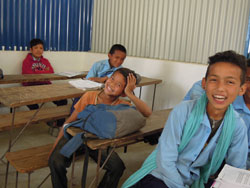“Thank you for coming all the way to this remote place of ours.”
200 school kids study at Hilpolali elementary school in the northern Dhding District, After the earthquake, they took classes in a temporary schoolhouse made of wood and tin sheets and occasionally had classes outdoors. (See the photo below.) |
| The previous temporary schoolhouse with one wall missing. It remained almost exposed to the wind. Limited number of classrooms sometimes forced children to study outdoors. (January 31st, 2016) |
After we launched the construction of the temporary schoolhouse, a boy came to pay a daily-visit to our site of construction. It was an 11-year-old boy named Angel Gurung (See the photo below.) “I look forward to studying in the new classroom. Thank you for coming all the way to this remote place of ours to build a schoolhouse,” said Angel.
 |
| Angel Gurung (age11). With his house destroyed by the earthquake, Angel came to see our site of construction with his wishes to build an earthquake-resistant house on his own. (January 30th, 2016) |
About two months later, the same smiling face could be found in the completed temporary schoolhouse. (See the photo below)
Angel said to us, “I would like to continue my studies even after the graduation from my elementary school.”
 |
| Angel (center) who looks happy with smiles on his face in the newly-built schoolhouse (March 17th, 2016) |
Further support in the future
Aside from the projects mentioned above, AAR Japan have provided support for persons with disabilities (PWDs). In collaboration with the Independent Living Center for Persons with Disabilities (CIL) in Nepal, we provided such stuff as food and water for as long as four months to 80 people including PWDs who got injured in the earthquake as well as PWDs and their families who are unable to lead a normal daily life as their houses are damaged or destroyed. Also, together with CIL, we initiated the production of the first Nepalese-made wheelchairs. We are to deliver to the affected of the earthquake a total of 50 wheelchairs that are light as they are made of aluminum. As of May 2016, we are planning to continue our relief efforts to materialize more projects, as well as maintaining production of wheelchairs, to provide rehabilitation programs and mental support to those who became disabled after the earthquake. |
| Takeshi IKEDA (left), AAR Japan, having been in consultation with the prospective user about the design of a wheelchair. CIL office (February 5th, 2016) |
AAR Japan are extremely grateful to all of you who have had concern over our activities and for your most generous support ever since right after the earthquake.
Once again, we greatly appreciate your ever-lasting generosity.
English editing by Ms Alexandra Lopatinsky
The article on this page has been translated by volunteers as part of the AAR Volunteer
Programme. Their generous contributions allow us to spread our activities and ideas globally, through an ever-growing selection of our reports from the field.

